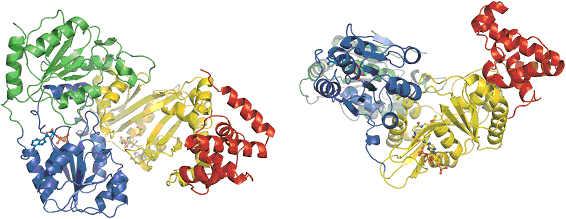

ABSTRACT
Post-transcriptional RNA modifications in the anticodon of transfer RNAs frequently contribute to the high fidelity of protein synthesis. In eubacteria, two genome-encoded transfer RNA (tRNA) species bear the same CAU sequence as the anticodons, which are differentiated by modified cytidines at the wobble positions. The elongator tRNAMet accepts an acetyl moiety at the wobble base to form N4-acetylcytidine (ac4C): an inherent modification ensures precise decoding of the AUG codon by strengthening C-G base-pair interaction and concurrently preventing misreading of the near cognate AUA codon. We have determined the crystal structure of tRNAMet cytidine acetyltransferase (TmcA) from Escherichia coli complexed with two natural ligands, acetyl-CoA and ADP, at 2.35A resolution. The structure unexpectedly reveals an idiosyncratic RNA helicase module fused with a GCN5-related N-acetyltransferase (GNAT) fold, which intimately crossinteract. Taken together with the biochemical evidence, we further unravelled the function of acetyl-CoA as an enzyme-activating switch, and propose that an RNA helicase motor driven by ATP hydrolysis is used to deliver the wobble base to the active centre of the GNAT domain.
REFERENCES
RNA helicase module in an acetyltransferase that modifies a specific tRNA anticodon.
Sarin Chimnaronk, Tateki Suzuki, Tetsuhiro Manita, Yoshiho Ikeuchi, Min Yao, Tsutomu Suzuki, and Isao Tanaka.
The EMBO J. 28, 1362-1373 (2009)